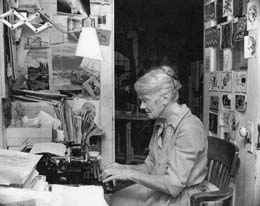On January 17, 1975, arts advocate and critic Maxine Cushing Gray (1909-1987) publishes the first issue of
Northwest Arts
, a bi-weekly journal devoted to arts news and opinion.
Northwest Arts
is available only by subscription. In addition to founding, publishing, and editing the publication, Gray also writes a regular feature, "The Column by M.C.G."
Gray published Northwest Arts from her home in Seattle's Northgate neighborhood, filing the publication's bills behind the salt shaker on the stove and handling correspondence in her small office off the kitchen. She was pleased with the publication's independence, and proud that she paid her contributing writers for their work. Northwest Arts accepted no advertising. Gray had spent the preceding 19 years as arts critic for the Argus, a publication that relied upon income from advertising, and she feared that accepting advertising for Northwest Arts would risk compromising her integrity.
A Cultural Watchdog
In her first column, Gray wrote: "Since Northwest Arts will carry no advertising, the readers are co-pilots of this enterprise and therefore should be heard from ... As to style, we will try to be accurate and direct (we have a low tolerance for elitism, inflated egos and critical vendettas). We will try for scoops ... And continually we will remind the various arts commissions -- and their staffs -- that they are being watched" (January 17, 1975, p. 2). The first issue featured a drawing of a Skagit Valley barn by Victor Steinbrueck, architect and Gray's former colleague at the Argus.
Gray paid contributors "minutely but promptly," $5 per poem, $10 per photograph, $15 per article (Seattle Post-Intelligencer, August 20, 1978). Many contributors were leading experts in their respective fields, and some of these people routinely returned their paychecks, often adding a financial contribution or ordering a gift subscription. The first issue was four pages. By the fourth issue, the publication was up to six pages. By the seventh issue, it reached eight pages, where it remained.
In the Know
Northwest Arts featured arts news of the Northwest states, Alaska, and British Columbia. The publication's regional events calendar listed every obtainable detail about dance, theater, music, special events, writing, and the visual arts -- performances, grant-application deadlines, funding opportunities, when artists were being interviewed on television, Met Opera radio broadcasts, Allied Arts meetings. By drawing such keen attention to these details of the region's artistic life, Gray helped others to notice and care about these aspects of civic life. Those who read Northwest Arts became, by definition, in the know.
By 1978, Northwest Arts had 750 subscribers, including residents of Canada, England, Sweden, Finland, Turkey, and Morocco. Gray felt tremendous pride in the publication, and had the issues bound by year. "These are the volumes I would say I am going to be buried with, except that I am going to be cremated," she told Seattle Post-Intelligencer reporter Jane Estes (August 20, 1978). Gray was especially delighted to note the presence of many libraries and museums among the publication's subscribers. "In a very small way, it's also putting Seattle on the map," she told Estes. Gray often scooped major national daily papers, much to the consternation of their editors. "I do a lot of phoning to get a scoop for the column," she told Estes. Her scoops, she added, were often credited to sources she named only as "unimpeachable leaks."
A Lifelong Mission
In 1985, in order to celebrate a decade of publication, Gray produced "Twenty Articles on the Art of Criticism." The booklet reproduced articles that had been previously published in Northwest Arts, and was a distributed to subscribers as a bonus.
Gray published Northwest Arts until a few weeks prior to her death in 1987. In her Seattle Post-Intelligencer obituary, reporter O. Casey Corr wrote, "Maxine Cushing Gray…earned a place in Seattle's history as editor/publisher of the Northwest Arts ... From that pulpit, she urged the arts world into ever higher levels of achievement" (November 2, 1987).

